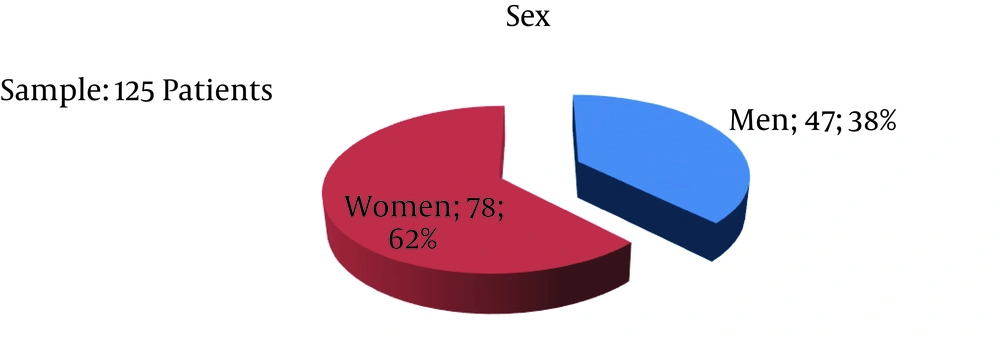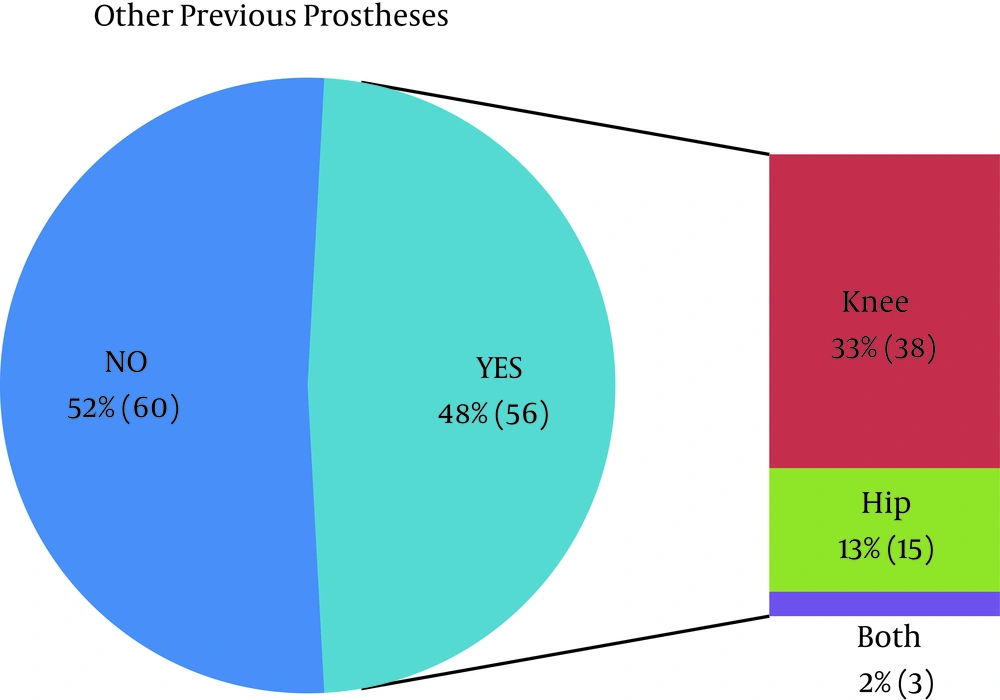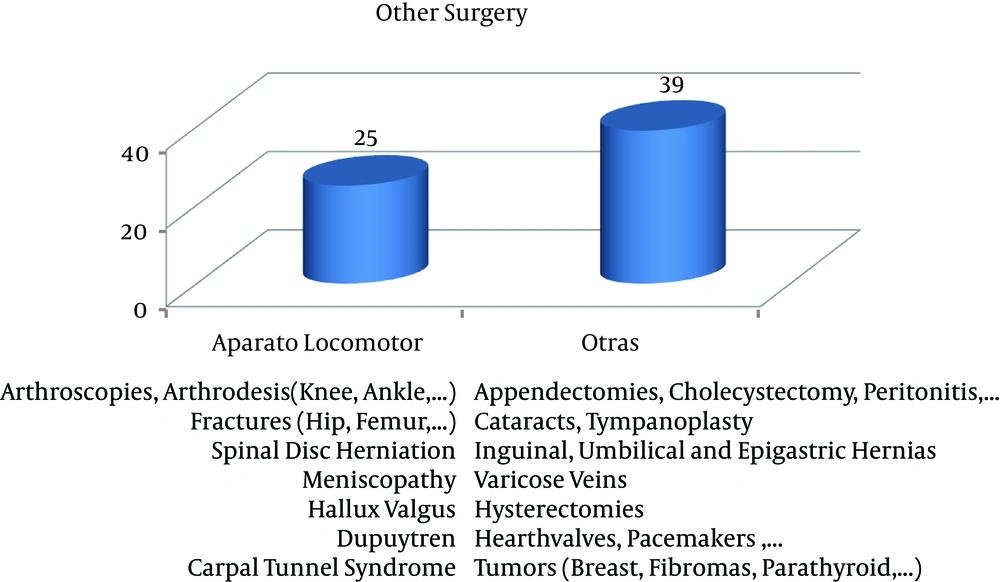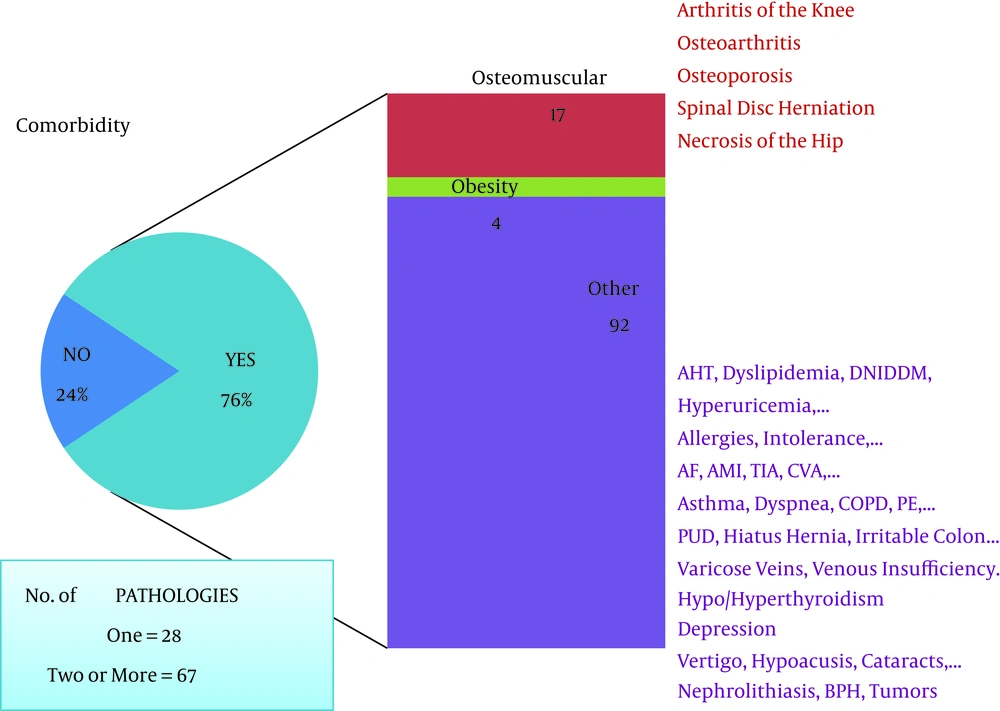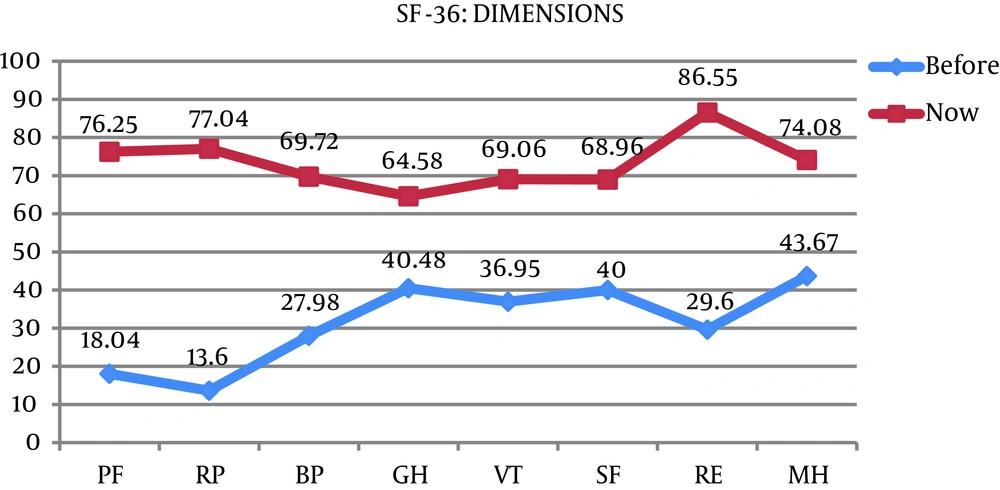1. Background
Osteoarthritis (OA) is a degenerative, disabling, prevalent and multifactorial disease that increases exponentially with age (1-3). It is divided into categories as primary and secondary osteoarthritis, depending on the cause (2). It mainly affects weight bearing joints; knees and hips are the most affected ones (1). Knee osteoarthritis is more disabling than any other orthopedic and musculoskeletal conditions (2).
The impact of osteoarthritis on health conditions is significant; function loss and use of social-health resources are among the suffering outcomes. It worsens the quality of life (QOL) regarding physical, emotional and social aspects (2). It is important to know the impact of osteoarthritis in QOL to make therapeutic decisions in the context of health policies and health economics (4).
Health-related quality of life (HRQOL) is the degree of perception of disease and/or its effects on physical, mental, emotional and social abilities of the patient (5). HRQOL is a global index of clinical results and assesses the therapeutic/surgical objectives in the health area. It can be measured with generic short form health survey (SF-36) questionnaire or the Western Ontario and McMaster universities osteoarthritis index (WOMAC) questionnaire (6).
Total knee arthroplasty (TKA) is the orthoprosthetic operation with the highest success rate. It shows survival rates and sustained results over 95% after 10 years. It reduces pain, improves function and HRQOL (7).
There are controversial studies on age and comorbidities as risk factors and its influence on the outcome on knee OA and knee arthroplasty replacement. Some authors such as Jones stated that the older people have more comorbidities but it does not affect the arthroplasty outcomes; while others (Katz, Becker and Bourne) (28), on the contrary, claimed that aging and comorbidities significantly affect total knee arthroplasties (TKA) outcomes.
2. Objectives
The current study aimed to assess the influence of age and comorbidities on quality of like in patients with knee OA and its outcomes after total knee replacement. The study hypothesis was that there are no significant clinical and statistical differences between the age and comorbidities and HRQOL in patients with knee osteoarthritis before and after the operation.
3. Methods
3.1. Scope of the Study
The study was carried out in the health area of Salamanca, which constitutes the city of Salamanca and the province. The study was performed from 2008 to 2012, included all patients with severe knee osteoarthritis referred from primary care doctors (PCD) of the local health centers to the Salamanca university hospital.
A quasi-experimental intervention assessed a sample of patients with knee OA before and after TKA. This type of epidemiological study has a scientific evidence level of grade II-1 according to the categories and classification of researches on the Canadian Task Force on Preventive Health Care (8).
The study included 125 patients (out of a total of 267) who underwent TKA surgery by the same surgeon and joint prosthesis Scorpio (Stryker®Orthopaedics, Mahwah, NJ, USA) from 2008 to 2012. The patients filled out the SF-36 questionnaire for the situation before and one-two months after the operation. Afterwards, the patients’ epicrisis report was reviewed to obtain the independent and determining variables (age, gender, comorbidities, other arthroplasties, other surgeries on the locomotor system and duration of hospitalization).
The inclusion criteria were: 1) adult patients from both genders with no age limit; 2) diagnosed knee osteoarthritis; 3) patients who underwent TKA surgery using Scorpio joint prosthesis and 4) different comorbidities. The exclusion criteria were: 1) patients with disorders preventing them from understanding or commenting on their clinical situation; 2) patients whose residential distance made it impossible to participate in to the survey; 3) patients who were not available because their contact information were missed; 4) patients who failed to fill out the report more than two times; 5) Patients who were lost during the study due to severe disease, death and previous contralateral surgery.
Data were collected following the clinical and epidemiological protocol created by the research team of the current study through performing personal interview with each patient. The SF-36 questionnaire was employed to assess HRQOL due to its viability, reliability, sensitivity to change and transcultural validation in Spain (8).
SF-36 is the most widely used generic questionnaire in the world. It makes it possible to compare the effect or result of an operation with other medical conditions (9). SF-36 measures HRQOL and provides a profile of the health condition that can be applied to the general population and to the patients, both in descriptive studies and in the assessment of clinical results. It is useful in small clinical studies to obtain a more detailed description of the health domains and study small changes in the health condition (10). SF-36 is a questionnaire with 36 items classified in eight dimensions: Physical functioning (10 items), role-physical (4 items), bodily pain (2 items), general health (5 items), vitality (4 items), social functioning (2 items), role-emotional (3 items) and mental health (5 items). Health transition item is not a dimension (contains 1 item) 10. Finally, the eight dimensions can be grouped in two major components: Physical health and mental health components (10).
Adequate frequency measures were calculated to assess the different indexes and indicators and their association with the different epidemiological variables. In different accurate estimations, prevalence and/or proportions and the respective confidence intervals (CI) were calculated as a measure of precision.
To assess the differences in the clinical parameters, the components of the SF-36 survey, other indexes and epidemiological variables, the Chi-square test was used for qualitative variables and the Student T-test and ANOVA for quantitative variables. Non-parametric tests were used if the variables did not meet the necessary conditions. The statistical significance level was set at 0.05. Also, to obtain the real proportion in the population and reliable results, the 95% CI with a 5% margin of error were calculated (inferential statistics).
A univariate analysis was made for all independent variables, bivariate analysis was carried out to assess and analyze statistical associations, and multivariate analysis was used to assess the determining variables.
The data were extracted from the medical histories and the SF-36 questionnaires and transferred to the SPSS ver. 20 for the statistical analysis.
4. Results
The demographic distribution of the subjects (n = 125) revealed that 78 patients were female (62%) and 47 (38%) male, which meant a 1.6:1 male/female ratio (Figure 1).
The distribution according to the age showed an average of 70 years, ranged 37 - 86. Most of the patients who underwent the surgery were from 62 to 80 years.
The mean duration of hospitalization was 8.12 days with a pick value at 8 days; ranging from 4 to 13. Most of the patients were hospitalized 6 - 9 days.
In the analysis for previous use of joint prosthesis (knee or hip), half of the subjects used orthoprosthesis prior to the current study. Among the subjects of the current study, 33% experienced TKA, 13% went through total hip arthroplasty (THA) and 2% used both prostheses (Figure 2).
When the previous surgical histories of the patients were analyzed, it was found that 20% had undergone a surgery on their musculoskeletal system and 31.2% had a history of previous surgery (Figure 3).
With regard to comorbidity, 76% of the patients showed associated comorbidity. Therefore, 28 patients presented one comorbidity and 67 patients revealed two or more comorbidities. Also, 15% (n = 17) showed osteomuscular morbidity, 3.5% (n = 17) had obesity and 81.4% (n = 92) showed other comorbidities (Figure 4).
Osteoarthritis is an important factor that affects all the aspects of the QOL (before TKA surgery). All the analyzed factors in SF-36 revealed a clinical improvement after the TKA surgery (TKA) (Figure 5).
The bivariate analysis (association study of HRQOL-SF36, before and after TKA surgery) revealed a statistically significant improvement in the scores of bodily pain (BP) (P = 0.000), general health (GH) (P = 0.000), vitality (VT) (P = 0.005), social functioning (SF) (P = 0.000), role-emotional (RE) (P = 0.050) and mental health (MH) (P = 0.000). No improvement was observed in physical functioning (PF) (P = 0.295) and in role-physical (RP) (P = 0.385) (Table 1).
| Before | After | Parametric Test | |||
|---|---|---|---|---|---|
| Items and Dimansions | Average | SD | Average | SD | P |
| SF-3 | 10.40 | 25.63 | 67.74 | 39.91 | 0.004 |
| SF-4 | 19.20 | 30.96 | 78.63 | 31.34 | 0.385 |
| SF-5 | 22.00 | 33.23 | 75.20 | 30.95 | 0.285 |
| SF-6 | 7.60 | 20.13 | 63.64 | 36.51 | 0.217 |
| SF-7 | 21.77 | 31.39 | 79.84 | 30.52 | 0.219 |
| SF-8 | 8.74 | 21.82 | 63.71 | 36.81 | 0.241 |
| SF-9 | 13.20 | 28.50 | 79.03 | 35.55 | 0.500 |
| SF-10 | 20.80 | 31.22 | 79.03 | 31.94 | 0.159 |
| SF-11 | 32.40 | 37.70 | 87.50 | 26.76 | 0.098 |
| SF-12 | 30.40 | 40.60 | 87.50 | 26.76 | 0.149 |
| Physical functioning | 18.04 | 22.12 | 76.25 | 24.73 | 0.295 |
| SF-13 | 16.80 | 37.53 | 79.67 | 40.40 | 0.064 |
| SF-14 | 12.80 | 33.54 | 75.00 | 43.47 | 0.064 |
| SF-15 | 15.20 | 36.04 | 77.42 | 41.98 | 0.211 |
| SF-16 | 9.60 | 29.57 | 77.24 | 42.10 | 0.599 |
| Role-physical | 13.60 | 29.70 | 77.04 | 37.42 | 0.385 |
| SF-21 | 27.36 | 21.33 | 69.44 | 23.35 | 0.247 |
| SF-22 | 28.60 | 18.97 | 70.00 | 23.54 | 0.734 |
| Bodily pain | 27.98 | 17.35 | 69.72 | 20.83 | 0.000 |
| SF-1 | 24.80 | 19.69 | 55.08 | 23.07 | 0.001 |
| SF-33 | 49.40 | 28.41 | 72.38 | 19.60 | 0.000 |
| SF-34 | 46.57 | 27.66 | 67.94 | 19.27 | 0.000 |
| SF-35 | 41.53 | 21.82 | 62.70 | 20.53 | 0.000 |
| SF-36 | 39.92 | 24.47 | 64.43 | 21.94 | 0.001 |
| General health | 40.48 | 19.05 | 64.58 | 15.28 | 0.000 |
| SF-23 | 37.76 | 25.68 | 65.60 | 22.66 | 0.345 |
| SF-27 | 38.21 | 27.22 | 69.35 | 20.94 | 0.000 |
| SF-29 | 35.45 | 28.03 | 72.26 | 19.20 | 0.000 |
| SF-31 | 36.29 | 25.16 | 68.55 | 21.66 | 0.099 |
| Vitality | 36.95 | 21.84 | 69.06 | 17.11 | 0.005 |
| SF-20 | 45.00 | 30.94 | 77.62 | 22.27 | 0.000 |
| SF-32 | 34.84 | 22.93 | 60.32 | 15.71 | 0.000 |
| Social functioning | 40.00 | 25.45 | 68.96 | 16.58 | 0.000 |
| SF-17 | 28.80 | 45.46 | 87.90 | 32.74 | 0.008 |
| SF-18 | 28.00 | 45.01 | 85.48 | 35.36 | 0.005 |
| SF-19 | 32.00 | 46.83 | 86.29 | 34.53 | 0.014 |
| Role-emotional | 29.60 | 43.62 | 86.55 | 32.06 | 0.050 |
| SF-24 | 45.00 | 31.19 | 76.64 | 17.54 | 0.000 |
| SF-25 | 46.34 | 32.11 | 79.52 | 16.55 | 0.000 |
| SF-26 | 38.70 | 25.44 | 68.16 | 22.01 | 0.000 |
| SF-28 | 47.32 | 30.75 | 76.13 | 17.42 | 0.000 |
| SF-30 | 41.77 | 28.17 | 70.00 | 21.86 | 0.000 |
| Mental health | 43.67 | 26.15 | 74.08 | 14.35 | 0.000 |
| Health transition item SF-2 | 35.04 | 27.01 | 68.13 | 22.67 | 0.041 |
The Comparison Between HRQOL-SF36 Dimensions, and Before and After TKA Surgery
The multivariate analysis (general linear model) of the age vs. scales and components of SF-36 indicated that age had a statistically significant influence over the variable before TKA surgery and on the scores of VT (P = 0.013), SF (P = 0.002) and MH (P = 0.017). This variable also had an influence on the mental component score (MCS) (P = 0.019). Following the variable after TKA surgery; age had a significant influence over the scores of GH (P = 0.025), SF (P = 0.021) and RE (P = 0.004), and a general effect on the MCS scores (P = 0.050). Totally, age had an influence on the MCS scores before and after TKA surgery, and affected GH only considering the variable after the TKA surgery (Table 2).
| Independent Variable: Age | |||||
|---|---|---|---|---|---|
| Dependent Variable: Dimension and Component | Type III Sum of Squares | DF | Quadratic Mean | F | Sig. (P < 0.05) |
| Before | |||||
| Physical functioning | 17911.248 | 30 | 597.042 | 1.349 | 0.148 |
| Role-physical | 24020.745 | 30 | 800.691 | 0.843 | 0.694 |
| Bodily pain | 10970.918 | 30 | 365.697 | 1.372 | 0.135 |
| General health | 13554.765 | 30 | 451.825 | 1.398 | 0.122 |
| Physical component | 10648.756 | 30 | 354.959 | 1.215 | 0.244 |
| Vitality | 21055.038 | 30 | 701.835 | 1.890 | 0.013 |
| Social functioning | 31495.059 | 30 | 1049.835 | 2.267 | 0.002 |
| Role-emotional | 69426.059 | 30 | 2314.202 | 1.422 | 0.110 |
| Mental health | 29294.345 | 30 | 976.478 | 1.837 | 0.017 |
| Mental component | 28946.089 | 30 | 964.870 | 1.820 | 0.019 |
| Health transition item | 22290.452 | 30 | 743.015 | 0.960 | 0.535 |
| After | |||||
| Physical functioning | 21769.718 | 30 | 725.657 | 1.340 | 0.153 |
| Role-physical | 50900.339 | 30 | 1696.678 | 1.416 | 0.113 |
| Bodily pain | 13317.352 | 30 | 443.912 | 1.229 | 0.232 |
| General health | 9963.148 | 30 | 332.105 | 1.754 | 0.025 |
| Physical component | 16148.388 | 30 | 538.280 | 1.452 | 0.097 |
| Vitality | 8898.696 | 30 | 296.623 | 1.271 | 0.199 |
| Social functioning | 11883.479 | 30 | 396.116 | 1.764 | 0.024 |
| Role-emotional | 48879.460 | 30 | 1629.315 | 2.125 | 0.004 |
| Mental health | 5833.176 | 30 | 194.439 | 1.069 | 0.396 |
| Mental component | 9344.806 | 30 | 311.494 | 1.567 | 0.050 |
| Health transition item | 12631.048 | 30 | 421.035 | 0.876 | 0.649 |
Multivariate Analysis of Age in Comparison to Dimensions and Components of SF-36
The bivariate analysis on the influence and association of the clinical-surgical variables with regard to the scales and components of the SF-36 survey indicated that the previous experience in TKA/THA were significantly associated with after TKA surgery with an average improvement in PF scores (P = 0.021); comorbidities were also associated with after TKA surgery with an improvement in MH (P = 0.036) (Table 3).
| **SF36 | Other Prosthesis PROSTHESES, Knee/Hip | Other Surgery on Musculoskeletal System | Risk for Comorbidity-Osteomyelitis/Obesity | |||
|---|---|---|---|---|---|---|
| Dimensions and Components | Before | After | Before | After | Before | After |
| Physical functioning | 0.572 | 0.021 | 0.336 | 0.142 | 0.169 | 0.970 |
| Role-physical | 0.755 | 0.397 | 0.208 | 0.348 | 0.975 | 0.593 |
| Bodily pain | 0.138 | 0.899 | 0.181 | 0.295 | 0.167 | 0.422 |
| General health | 0.262 | 0.261 | 0.599 | 0.303 | 0.604 | 0.463 |
| Physical component | 0.550 | 0.915 | 0.241 | 0.297 | 0.317 | 0.632 |
| Vitality | 0.078 | 0.570 | 0.701 | 0.725 | 0.314 | 0.960 |
| Social functioning | 0.423 | 0.873 | 0.511 | 0.742 | 0.394 | 0.579 |
| Role-emotional | 0.711 | 0.249 | 0.442 | 0.402 | 0.469 | 0.372 |
| Mental health | 0.548 | 0.760 | 0.645 | 0.372 | 0.149 | 0.036 |
| Mental component | 0.633 | 0.622 | 0.402 | 0.668 | 0.407 | 0.670 |
| Health transition item SF-2 | 0.331 | 0.261 | 0.248 | 0.849 | 0.301 | 0.465 |
The Association Between Clinical-Surgical Variables and HRQOL-SF36
5. Discussion
Osteoarthritis usually affects the knee, with an incidence that increases exponentially with age; particularly in females. It is no surprise that age has an influence on patient’s quality of life before and after the intervention; In knee OA, the higher the age, the greater the severity.
A female-to-male ratio of 1.6:1 (62% female, 38% male) was observed in the current study (Figure 1). Other national studies showed higher ratios (2.7:1 (11), 3:1 (12-14), 4:1 (15), 4.9:1 (16), and international studies presented similar ratios (1.5:1 (17), 1.6:1(18), 2.2:1 (19). All the studies, including the current one, showed a higher incidence in females.
Knee osteoarthritis is one of the most disabling conditions, with the highest impact on the personal autonomy of elderly people. Its incidence increases with age, and it affects more than 33% of people over 70 years old in Spain (15).
The mean age in the subjects of the current study at the time of surgery was 70 years, with a normal distribution. National studies showed variable mean ages of 66.5 ± 6.2 years (12), 69.7 ± 6.6 years (13), 66.7 ± 8.6 years (14), 70.12 ± 5.75 years (16), 71.9 years (11) and 74 ± 2.3 years (15), with a progressive ageing in the population (over the last 25 years). Other international studies revealed similar rates to those of the current study (68, (19) and 72 years (17)). As a consequence, the mean age of the patients who underwent surgery and monitored in the current study was similar to those of the other studies including national and international populations. With regard to the sample of the current study, the patients were a part of the population of the region of Castile and León, and specifically from the health area of Salamanca, constitutes the city and province of Salamanca and is part of the autonomous community of Castile and León, which has one of the highest indexes of ageing population in Spain.
The mean duration of hospitalization is the result of different healthcare systems (16). The mean of the duration of hospitalization was 8.2 days in the current study; ranged 4 - 17. Some Spanish studies revealed the duration of hospitalization as 14.38 ± 4.74 (16), 13 ± 5 (11) and 9.2 ± 2 days for the subjects < 75 years old and 9.5 ± 3 days for those >75 years (15), with a progressive decrease over time. The studies conducted in the other countries revealed the duration of hospitalization similar to that of the current study; 7 ± 2 days for the subjects < 80 years, 6 ± 2 days in those > 80 years, hospitalization and rehabilitation treatments 9 ± 3 and 11 ± 5 days, respectively (20); another study reported a duration of hospital stay as 8.2 days (19), which was similar to that of the current study. The duration of hospital stay decreases over time through the improvement of surgical techniques and the immediate postoperative rehabilitation treatments.
Adult and symptomatic patients with osteoarthritis will probably have more than one affected weight bearing joint, in the knee, the hip or a similar contralateral joints 21. Ramón Rona also reported that 90% of the patients with knee pain have bilateral symptoms (16). With regard to the presence of previous joint prostheses, half of the patients in the current study had a previous experience in the use of orthoprosthesis: 33% in the knee, 13% in the hip and 2% in both; which proves that osteoarthritis is a bilateral condition that affects especially weight bearing joints. Studies conducted in Spain revealed contralateral surgery in 24.6% of the patients < 75 years old and 33% in patients > 75 years old (15). Some studies in the other countries found contralateral surgery of the knee in 17% of the patients (18), 20% of the patients < 80 years old, 54% of the patients > 80 years old, and 35% of those who underwent THA surgery (21). Therefore, the global rate of orthoprosthesis adjustment records was similar to those of the current study, and in both cases these records were higher in older groups.
There was a 20% increase in other surgeries of the locomotor system in patients with knee osteoarthritis in the current study, which was in line with the results of a national study (23.9% (16)). The studies showed great variability. Wallace reported meniscectomy in 5.2% of all patients with TKA (18), Parent reported 32.3% of previous surgery of the lower limbs (meniscectomy was the most common one) (22), and Ostendorf reported a rate of 13.3% (10).
Comorbidity is defined as a diagnosis or a medical condition related to health (22). The current study observed that 76% of the patients presented one or more comorbidities (22.4% one comorbidity, 53.6% two or more), which was in line with the average comorbidity in the Spanish Health System. International studies showed similar levels of comorbidity (Mangione reported 72% (23), Ostendorf reported 66.8% (10) and Ackerman reported 61% rate (24)). Other national studies reported even higher levels of comorbidity (Ramón reported a 95.8% rate of comorbidities 16; Moreno a 88.5% of comorbidity in patients <75 years old and 86.3% of comorbidity in patients > 75 years old (15)).
A clinical improvement was observed in all dimensions of the survey; this improvement was significant for all dimensions except the role-physical and physical function, although TKA substantially improves physical function, as researchers reported (19).
It was observed that age had an influence on BP and VT before the intervention; the pain was less tolerated and caused higher functioning disability and dependence. According to Katz, the main predictor for postoperative complications and mortality was age (25, 26). According to Moreno, in higher age there was higher comorbidity and an increase in complications (15).
The age of the patients was associated with comorbidity and/or chronic multiple pathologies. It leads to lower autonomy and higher physical, emotional and social dependence over time. According to the data from the Spanish Ministry of Health, patients with chronic conditions have an average of 2.8 pathologies.
Singh observed that patients > 60 with osteoarthritis had more limitations in ADLs than patients of the same age without osteoarthritis (27). Bachmeier maintained that previous use of joint prostheses did not lead to a worse result after the surgery, as in the current study (17). Parent (22) and Katz (26) reported that preoperative factors were the predictors for mobility and associated outcomes.
The current study observed that comorbidity was associated after the intervention with an improvement in MH, since TKA improves pain, PF, MH and QOL, as most of authors already stated (19). Although Jones proved that patients > 80 presented 4 ± 2 comorbidities and patients < 80 presented 3.5 ± 2 comorbidities, comorbidity did not have a significant influence on the pain, PF and QOL after TKA and THA (20), as was the case in the current study. On the contrary, Katz (26), Becker (28) and Bourne (29) stated that comorbidity and other factors were the predictors for the outcome of arthroplasty surgery. Therefore, there is controversy on comorbidities and its influence on TKA outcome.
The current study observed that previous use of other joint prostheses improved PF after the surgery, and that comorbidities were associated with an improvement in MH. It was in line with most of the authors (10, 15-17, 19, 21, 23), who stated that total replacement arthroplasty improved pain, PF, MH, SA and HRQOL.
Knee OA causes limitations in daily life activities and therefore limits social functioning. Although after the surgery there is an improvement in all other dimensions, particularly pain and PF, it is difficult for the patients to recover the lost SF. Patients who underwent surgery more than five years after the onset of OA showed worse RP and GH, and also worse VT, RE and MH than those who underwent surgery less than five years of the same condition; probably due to ageing, with the subsequent worsening of physical and mental health, low improvement in HRQOL was also explained with the higher number of comorbidities, as Bjorgul already showed (30). The current study confirmed that patients > 75 had more comorbidities than patients below that age.
5.1. Conclusion
Total knee arthroplasty (TKA) is justified according to the perception of clinical improvement and the improvement of health-related quality of life (HRQOL) reported by the patients. Age influences knee OA and TKA outcomes. Comorbidities have no influence on Knee OA, but affect mental health after the intervention.
